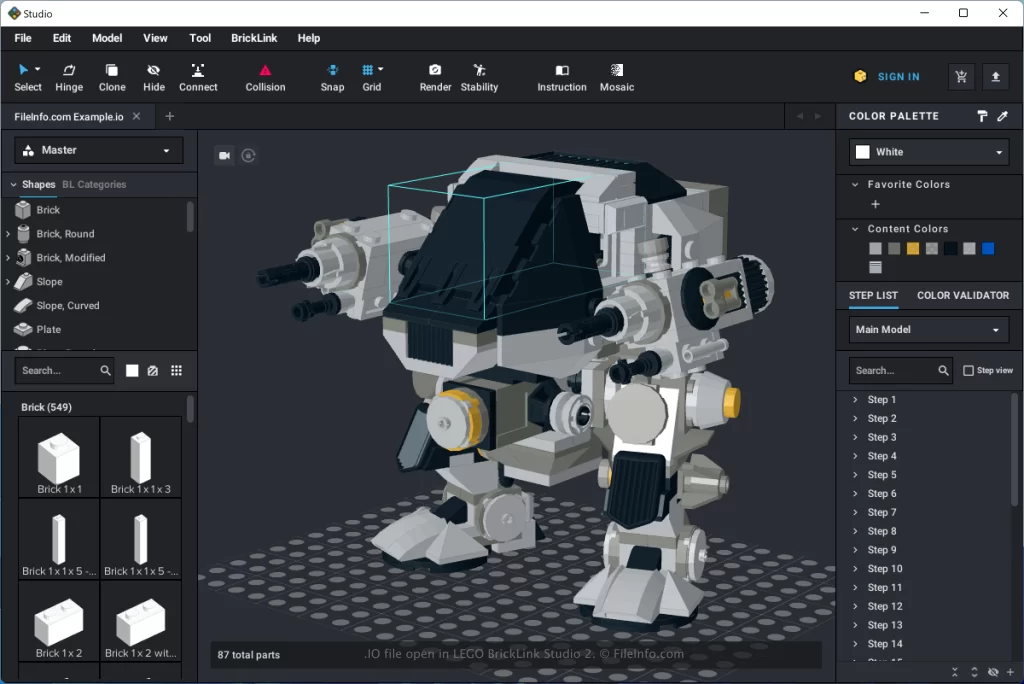.IO File Extension

BrickLink Studio LEGO Model
| Developer | LEGO BrickLink |
| Popularity | |
| Category | Data Files |
| Format | .IO |
| Cross Platform | Update Soon |
What is an IO file?
.IO files, often associated with specific applications or software, are unique in their functionality and utility. They are not standard file types like .docx or .jpg, but instead, serve specific purposes within the context of the software they are associated with.

More Information.
Initially, .IO files were designed to serve distinct purposes, such as storing configuration data, user information, or process-specific data. Over time, their use has evolved, but the core principle remains the same: to facilitate specific functionalities within software applications.
Origin Of This File.
The .IO file extension originated within the tech industry, often linked to particular software or applications. Its creation was driven by the need for specialized file formats that cater to specific functionalities within software environments.
File Structure Technical Specification.
.IO files may vary in structure and technical specifications depending on their intended use. Typically, they might contain binary data, text, or a mix of both. Understanding their structure requires knowledge of the specific application they are associated with.
How to Convert the File?
Windows
- Identify File Type: Determine the format of the file you wish to convert.
- Choose Conversion Software: Select a file conversion program compatible with Windows. Popular choices include Adobe Acrobat for PDF conversions, Format Factory for media files, and Zamzar for online conversion.
- Install Software: Download and install your chosen software.
- Convert File: Open the software, upload your file, select the desired output format, and start the conversion process.
- Save Converted File: Once the conversion is complete, save the new file to your desired location.
Linux
- Identify File Type: Determine the file format to be converted.
- Install Conversion Tools: Use package managers like apt or yum to install file conversion tools. For example, ffmpeg for video and audio files, imagemagick for images, and pandoc for document files.
- Use Terminal for Conversion: Most Linux file conversions can be done using command line. For instance, to convert a JPEG image to PNG, you would use a command like convert image.jpg image.png.
- Check Output: Verify the converted file in the specified output directory.
Mac
- Determine File Type: Understand the format of the file you need to convert.
- Select Conversion Application: Choose a file conversion program suitable for macOS, such as Adobe Acrobat for PDFs or HandBrake for video files.
- Install Application: Download and install the conversion application from the App Store or the software’s official website.
- Perform Conversion: Open the application, import your file, choose your desired output format, and begin the conversion.
- Save New File: Save the newly converted file in your preferred location on your Mac.
Android
- Identify the File Format: Know the current and desired file formats.
- Download Conversion App: Use the Google Play Store to find and install a file conversion app. There are apps for specific file types like media converters, document converters, etc.
- Convert Using App: Open the app, upload the file, choose the target format, and start the conversion.
- Access Converted File:
Once the conversion is complete, the app will usually provide an option to either view or save the converted file. Save it to your desired location on your Android device.
iOS
- Determine File Type: First, identify the format of the file you need to convert.
- Find a Suitable App: Search the App Store for a file conversion app that supports the file type you’re working with. There are various apps available for different types of file conversions, such as The File Converter, Documents, or specific media converters.
- Install and Open the App: Download and install the chosen app. Once installed, open it.
- Upload and Convert File: In the app, upload the file that needs conversion. Select the desired output format and initiate the conversion process.
- Save or Share Converted File: After the conversion, the app will offer options to either save the file to your device or share it through various means like email or cloud storage services.
Advantages And Disadvantages.
Advantages:
- Specialization: Tailored to serve specific purposes within an application.
- Efficiency: Optimized for the tasks they are designed to perform.
Disadvantages:
- Limited Compatibility: Often only usable within the specific software they are designed for.
- Complexity: Can be difficult to understand or modify without specific knowledge of the software.
How to Open IO?
Open In Windows
To open .IO files in Windows:
- Identify the software associated with the file.
- Install or run the relevant software.
- Use the software’s interface to open the file.
Open In Linux
In Linux, opening .IO files involves:
- Identifying the parent application.
- Installing any necessary software via package managers like apt or yum.
- Utilizing command-line or GUI methods to access the file.
Open In MAC
For Mac users:
- Determine the application linked to the .IO file.
- Ensure the software is compatible with macOS.
- Use the application to access or manipulate the file.
Open In Android
Android users can open .IO files by:
- Finding the associated app, often through the Google Play Store.
- Installing and running the app.
- Using the app’s functionalities to interact with the file.
Open In IOS
On iOS devices:
- Identify the iOS-compatible application associated with the .IO file.
- Download and install the app from the App Store.
- Open the file within the app environment.
Open in Others
For other platforms, opening .IO files requires:
- Identifying compatible software or applications for the specific platform.
- Installing the necessary software.
- Utilizing the software to access the .IO file, which might involve specific platform-dependent procedures.













